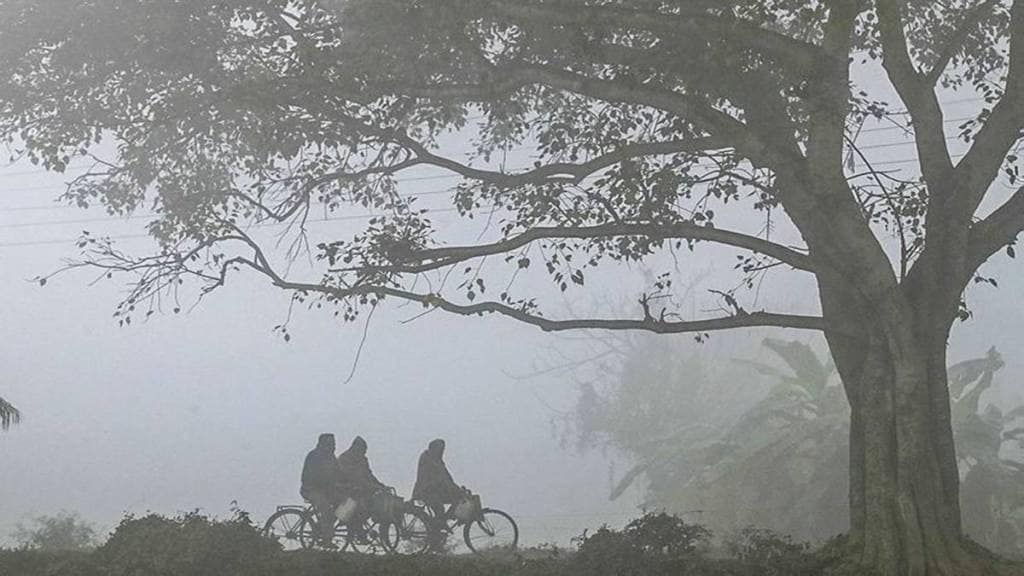North India has been experiencing significant weather changes as a result of the ongoing western disturbance, leading to cloudy skies and scattered rainfall across several regions. The weather has transformed the usual winter chill into a damp and cloudy experience, with Delhi-NCR seeing dark clouds since Monday evening and drizzling in the early hours of Tuesday. According to the Indian Meteorological Department (IMD), these weather conditions are expected to persist until Wednesday, with more rain likely to affect various states.
After a spell of dense fog earlier in the day, Delhi-NCR has witnessed a dramatic change in weather, thanks to early morning showers that helped improve visibility significantly. The minimum temperature in the capital is predicted to be 12°C, while the maximum will hover around 23°C. Light rain and cloudy weather are forecasted throughout the day, offering some relief from the typical winter chill.
The minimum temperature in Delhi is expected to increase, bringing some relief. However, the city’s air quality remains a concern, with the Air Quality Index (AQI) recorded at 243, indicating a “poor” level of pollution at 7 am. According to the India Meteorological Department (IMD), areas such as Bawana, Alipur, Pitampura, Mundaka, Preet Vihar, Dwarka, Lodi Road, Delhi Airport, Vasant Vihar, and Lajpat Nagar may experience light rain throughout the day.
Rain Alert Issued Across North India
The IMD has issued a rain alert across several districts in Western Uttar Pradesh, with light rain predicted for today and tomorrow. Key districts affected include Saharanpur, Muzaffarnagar, Ghaziabad, Noida, Aligarh, Mathura, and Meerut. Similar weather conditions, including cloudy skies and rain, are expected to persist throughout Wednesday as well.
The IMD has also predicted substantial rainfall in 14 districts of Haryana, with cities like Bhiwani, Jind, Karnal, and Gurugram likely to see showers. The rain is expected to continue in these regions through Wednesday, making travel conditions potentially challenging. The forecast warns residents to stay prepared for disruptions caused by the downpour.
Several districts in Punjab are also on high alert, with rain expected to affect the region in the coming days. The weather department has advised residents to remain cautious, as the rain could impact daily activities.
The ongoing rain has brought cooler temperatures to the plains, with a slight drop in both the minimum and maximum temperatures expected in Delhi-NCR, Haryana, Western Uttar Pradesh, and Punjab. However, the IMD has assured that the cold conditions won’t be severe, with temperatures only dropping by 1 or 2°C. Meanwhile, higher altitudes such as Himachal Pradesh, Uttarakhand, and Jammu and Kashmir are experiencing snowfall, leading to colder conditions in these regions.
Rajasthan: Yellow Alert for Rain and Cold
Parts of Rajasthan, including Jaipur, Ajmer, and Alwar, have been placed under a yellow alert as the western disturbance continues to bring rain to the state. While dry weather is predicted for much of Rajasthan, the eastern and northern areas will likely experience showers over the next couple of days. Cold conditions persist in regions like Ganganagar, where temperatures have dipped to 4°C, and other districts like Churu and Sangaria have also reported low minimums. Jaipur is expected to see temperatures of 12.4°C at night and 25°C during the day.
Jammu and Kashmir: Extreme Cold and Snowfall
The Jammu and Kashmir region is facing an intense cold wave, with temperatures plummeting as low as -16.06°C on February 4, 2025. The IMD forecasts that temperatures will range between -27.42°C and -12.13°C in the coming days, with high levels of humidity (around 89%) contributing to the frigid conditions. The weather in the region will include snowfall, with some areas reporting icy conditions. Residents are advised to take extra precautions, especially in high-altitude regions, where conditions are more severe.
In addition to the extreme cold, Jammu and Kashmir has an air quality index (AQI) reading of 0.0, which may indicate no significant pollution but should still be monitored for any changes. The IMD has forecasted further drops in temperature, with February 5 seeing minimum temperatures of -26.59°C and a maximum of -15.14°C. The weather will continue to remain cold, with fluctuating humidity levels throughout the week.
North India’s weather is set to remain volatile for the next few days, with continued rainfall, light to moderate temperatures, and a mixture of snowy conditions in higher altitudes. The IMD recommends keeping an eye on local weather alerts to adjust travel plans and stay protected from the colder-than-usual temperatures and occasional rain.

